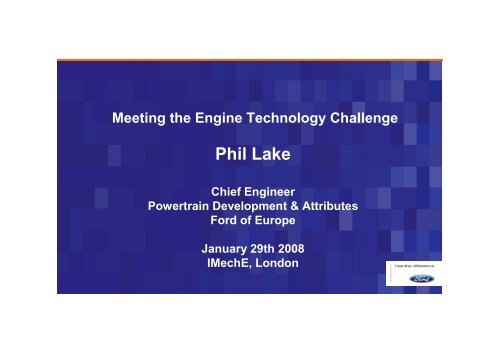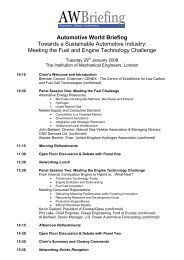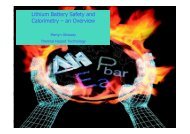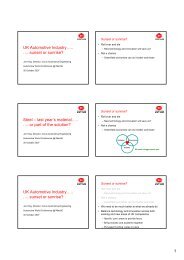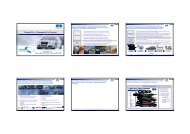Phil Lake
Phil Lake, Ford of Europe - AWBriefing
Phil Lake, Ford of Europe - AWBriefing
You also want an ePaper? Increase the reach of your titles
YUMPU automatically turns print PDFs into web optimized ePapers that Google loves.
Meeting the Engine Technology Challenge<br />
<strong>Phil</strong> <strong>Lake</strong><br />
Chief Engineer<br />
Powertrain Development & Attributes<br />
Ford of Europe<br />
January 29th 2008<br />
IMechE, London
Sustainability Roadmap:<br />
Powertrain Technologies/Energy Supply<br />
Energy Supply CO2 Emission<br />
Engine & Transmission<br />
Improvement<br />
Hybrid Electric Vehicles<br />
Plug-in HEV‘s<br />
Electricity<br />
Hydrogen<br />
Reformulated/Bio mass derived fuels<br />
Petroleum based fuels<br />
Hydrogen Fuel Cell Vehicles<br />
2007 2012 2020 2030
Technology Roadmap (Schematical Overview)<br />
% CO 2 Reduction<br />
Ethanol<br />
DISI<br />
TC<br />
Petrol DI<br />
Micro Hybr.<br />
Diesel<br />
CBioG<br />
Diesel<br />
Micro Hybr.<br />
CNG<br />
H2 ICE<br />
City<br />
Gasoline<br />
Full Hybrid<br />
Highway<br />
Fuel Cell<br />
Petrol DI<br />
PFI Petrol<br />
Cost
How we address the Automotive Contribution<br />
Powertrain Transmissions Hybrids<br />
Vehicle<br />
Fuel<br />
Focus is on technologies which have a broad application, are cost effective.
Fuel Economy Stepwise Improvements<br />
Examples - Warm Up<br />
Delta Fuel Economy [%]<br />
7<br />
6<br />
5<br />
4<br />
3<br />
2<br />
1<br />
0<br />
30 40 50 60 70 80 90<br />
• Heat Energy Recovery is a clearly identified opportunity<br />
• To maximise the benefit needs a good systems and<br />
physics based approach<br />
Typical B Car - 50mph Cruise in 5 th Gear<br />
Delta FE vs Transmission Oil Temperature<br />
Engine Oil Temperature = 90°C<br />
Transmission<br />
Engine<br />
Delta FE vs Engine Oil Temperature<br />
Transmission Oil Temperature = 60°C<br />
Oil Temperature [°C]
Fuel Economy Stepwise Improvements<br />
Examples – Variable Flow Oil Pump<br />
• Variable Flow Oil Pump can significantly reduce the<br />
pumping effort on the engine at higher engine<br />
speeds resulting in 1 – 2% FE at < £20 / vehicle
Fuel Economy Stepwise Improvements<br />
Examples – Laser Honing<br />
Frictional torque (Nm)<br />
0.08<br />
0.07<br />
0.06<br />
0.05<br />
0.04<br />
0.03<br />
Plain<br />
0.02<br />
LTS<br />
0.01<br />
LTS repeat<br />
Plain repeat<br />
0<br />
0 100 200 300 400 500 600 700<br />
Bearing load (N)<br />
BP/Ford Alliance – Joint Engineering & Development
Powertrain Development: Diesel and Petrol Engines<br />
Diesel Emissions<br />
Direct Injection<br />
Common Rail FIE<br />
PM Trap<br />
“Right Sizing“<br />
Adv. Boosting<br />
Low Temperature<br />
Combustion (HCCI)<br />
Any Powertrain<br />
Power/Torque Increase<br />
Parasitic Loss Red.<br />
Weight Red.<br />
Adv. Controls<br />
Gasoline Fuel Economy<br />
Variable Valve Timing<br />
Direct Injection<br />
Stratified Lean Burn<br />
Common Rail FIE<br />
Downsizing/Cyl. Deact.<br />
Adv. Boosting<br />
Variable Comp. Ratio<br />
NOx Catalysis<br />
Low Temp. Comb. (CAI)<br />
New IC Engine Process<br />
Tailored Fuels<br />
NOx Catalysis<br />
Direct Fuel Injection<br />
Boosted<br />
HCCI/CAI<br />
Powertrain<br />
Tailored Fuel<br />
Integrated Ox. Cat/ PM/NOx Aftertreatm.
Spray Guided DI Turbo Engine
Engine Torque Comparison<br />
1.6l SGDI T/C<br />
2.0l PFI<br />
2.0l Diesel T/C<br />
Engine Torque [Nm]<br />
1000 1500 2000 2500 3000 3500 4000 4500 5000 5500 6000 6500<br />
Engine Speed [rpm]<br />
• The 2.0 Diesel Engine provides higher nominal engine torque<br />
• The SGDI T/C Engine delivers high torque over a wider revolution range<br />
Engine torque has to be transformed for the vehicle through the<br />
transmission according to available revolution range
Torque at Wheel, Top Gear<br />
Wheel Torque [Nm]<br />
1.6l SGDI T/C<br />
2.0l PFI<br />
2.0l Diesel T/C<br />
20 40 60 80 100 120 140 160 180 200 220<br />
Vehicle Speed [kph]<br />
• In top gear also the torque at the wheel are at similar levels<br />
for Diesel and Gas<br />
Resulting In-Gear accelerations (i.e. 80-120kph) are equivalent
SGDI X-Brand System Solution<br />
Common Combustion System and Fuel System Components<br />
Sigma 1.6 SGDI<br />
Jaguar AJV8 SGDI<br />
Volvo SI6 SGDI
Fuel Economy Technology Leaps<br />
Engine Downsizing<br />
1.4 DV4 DIESEL<br />
1.3 ROCAM<br />
1.4 SIGMA<br />
1.0L I3 Concept
Transmission Development: Manual and Automatic<br />
Layshaft<br />
Dual Wet Clutch Transmissions<br />
(Wet Powershift) for higher<br />
torque applications<br />
Dual Dry Clutch<br />
Transmissions<br />
(Dry Powershift)<br />
for lower and medium<br />
torque applications.<br />
Any Transimission<br />
Friction reduction<br />
Low friction transmission fluids<br />
Active transmission fluid warm<br />
Dynamic seamless reconnect<br />
Weight Red.<br />
Future Transmissions<br />
Epicyclic<br />
Low loss Torque converters<br />
8 speed<br />
Clutch lift strategy<br />
Transmission
Advanced Transmissions<br />
Getrag – Ford “Powershift”
Plug-In Hybrid Electric Vehicles<br />
Strategic Drivers for PHEV<br />
• Energy Security - reduce petroleum imports through the use of<br />
electrical energy<br />
• CO 2 / Climate Change – shift CO 2 production to electrical utility<br />
industry; increased potential for significant reduction through<br />
renewable energy sources (wind, hydro) or nuclear<br />
• Customer Benefit – incremental cost of battery must be offset by<br />
savings from fuel economy combined with other subsidies from<br />
industry/government<br />
• Competition – Ford and Toyota are the only OEM’s with full HEVs<br />
for sale to the customer
Fuel Cell History at Ford<br />
1999<br />
P2000 HFC<br />
CGH2<br />
2005<br />
FCEV Hybrid<br />
2001<br />
CGH2<br />
Mazda Premacy<br />
2000<br />
Methanol<br />
Ford Focus FCV<br />
2000<br />
CGH2<br />
Ford Focus FC5<br />
Methanol<br />
3 rd Generation
Fuel Cell On-going Challenges<br />
Significant Technical Breakthroughs are required to make FCVs<br />
commercially viable:<br />
• Affordability<br />
• Hydrogen On-Board Storage<br />
• Durability Improvements<br />
• Safety Codes and Standards<br />
• Simultaneous Hydrogen Infrastructure
Powertrain Technology ‘Limit’ – Car & Energy Solutions<br />
Tailpipe NOx Emissions<br />
0.07 g/mile<br />
0.02 g/mile<br />
0 g/mile<br />
Renewable<br />
Diesel<br />
Engine<br />
Renewable<br />
Spark<br />
Ignition<br />
Engine<br />
Renewable<br />
H 2<br />
FCEV<br />
Infrastructure Changes<br />
Carbon Sequestration<br />
Renewable Fuels<br />
(H 2 or Bio-Fuels)<br />
Powertrain<br />
Technology<br />
Limit<br />
Advanced<br />
Diesel<br />
Engine<br />
Diesel<br />
Engine<br />
Hybrid<br />
Gasoline<br />
Engine<br />
Hybrid<br />
H 2<br />
(NG)<br />
FCEV<br />
Advanced<br />
Gasoline<br />
Engine<br />
Current<br />
Gasoline<br />
Engine<br />
0 50 100 150 200<br />
Well to Wheels CO 2<br />
(g/km)<br />
An integrated approach is required to meet ‘near Zero’ CO 2 ,<br />
• Renewable / Bio blended Gasoline & Diesel<br />
• Hydrogen from Renewable sources
Deployment Strategy – CO 2 Improvements Impact All<br />
Fuel Economy, CO 2<br />
&<br />
Tailpipe Emissions<br />
Environmentally<br />
responsible vehicles…<br />
High relative volumes<br />
to make a global difference<br />
Accessibility<br />
( Vehicle Purchase &<br />
Running Costs )<br />
…Employing affordable<br />
technologies & fuels …<br />
Performance<br />
&<br />
Driving Practicality<br />
… Which continue to<br />
satisfy & delight the user
Conclusions<br />
• No ‘Silver Bullet’ exists – parallel powertrain technology<br />
development will continue<br />
• Combined ‘Car & Energy’ solutions will be necessary to achieve<br />
fundamental CO 2 emission reduction<br />
• Liquid fuels, supplemented with renewables will provide the<br />
most practical solutions in the short and medium term<br />
• Technology solutions must be ‘affordable’ to permit wide scale<br />
deployment & Global CO 2 benefit<br />
• Vehicle cost<br />
• Cost of ownership<br />
• Fuel Infrastructure<br />
• Auto companies, Fuel Companies, Technology suppliers and<br />
Governments need to collaborate to facilitate the<br />
revolution, and take an holistic approach.
Backup Material
Life-Cycle Approach („Well-To-Wheel“)
„Well-To-Wheel“ Overview<br />
CO 2 Emissions<br />
petrol<br />
diesel<br />
Gasoline<br />
Hybrid<br />
Bio-ethanol<br />
(sugar-beet)<br />
Bio-ethanol<br />
(cellulose)<br />
Absorbed by plants<br />
Absorbed by plants<br />
Hydrogen<br />
Fuel Cell<br />
0 50 100 150 200 CO 2<br />
g/km


